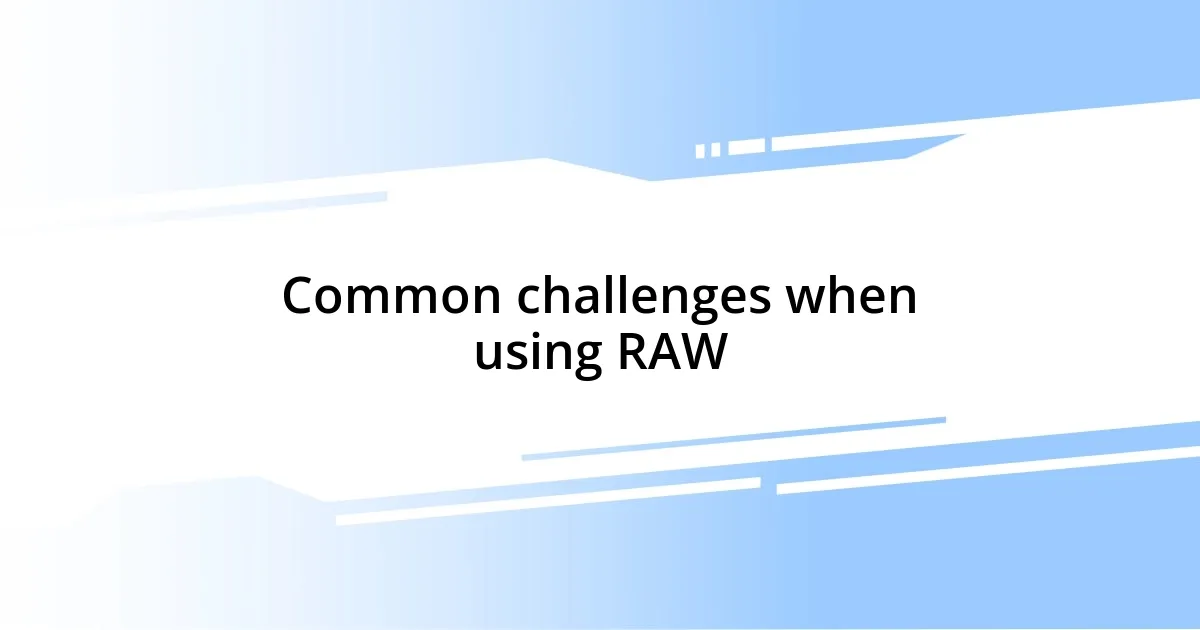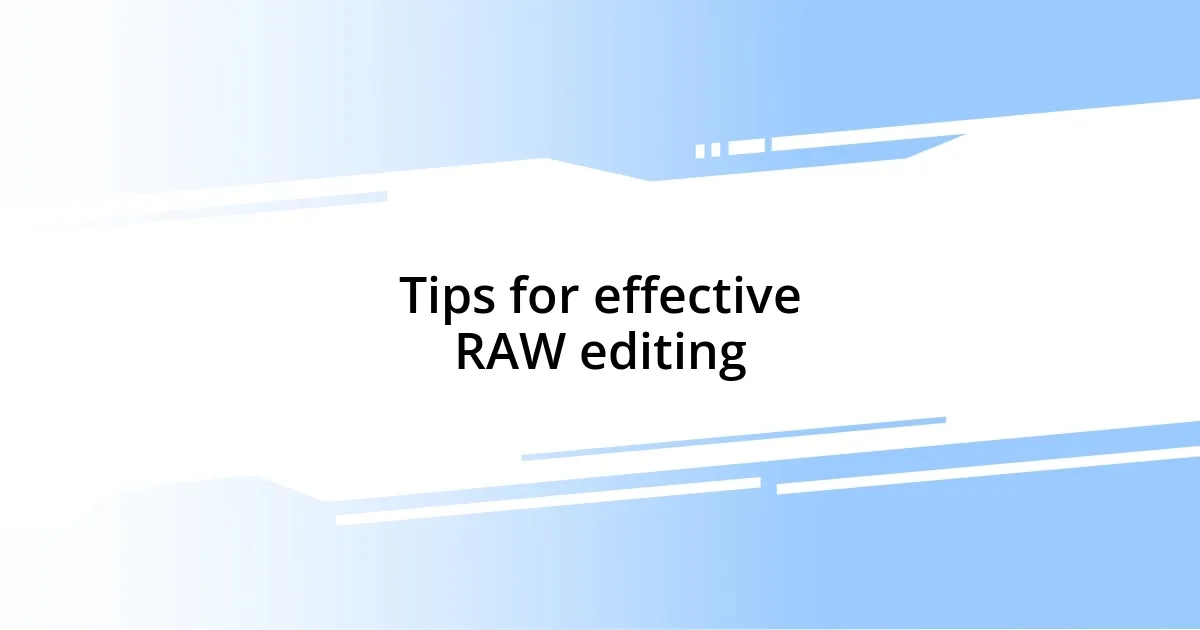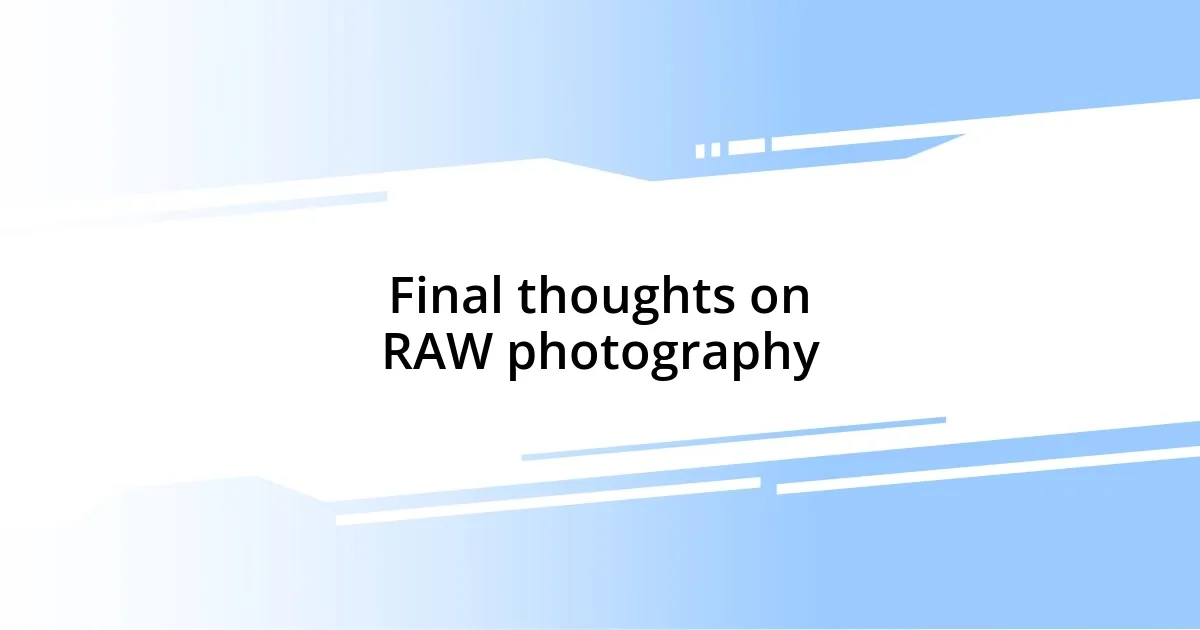Key takeaways:
- RAW image format retains all sensor data, offering greater flexibility in post-processing compared to JPEG, allowing for significant adjustments without quality loss.
- Shooting in RAW enhances dynamic range and image quality, enabling photographers to recover details in challenging lighting situations.
- While RAW files are larger and require more storage, they facilitate non-destructive editing, providing more creative control and opportunities to refine images.
- Post-processing in RAW promotes artistic experimentation, allowing photographers to convey emotion and mood effectively, transforming ordinary shots into compelling visuals.

Understanding RAW image format
When I first delved into the world of photography, understanding the RAW image format felt like discovering a hidden treasure. Unlike JPEGs, which are processed and compressed, RAW files retain all the data captured by the camera sensor. This means every detail, every subtle shift in color and tone is preserved, allowing for greater flexibility in post-processing. Isn’t it exciting to think that each RAW image holds the potential for perfecting your vision?
I remember the first time I edited a RAW image—it was like peeling back layers of an uncomfortable truth. I realized that I could adjust exposure, contrast, and shadows without losing quality. This level of control can be both exhilarating and overwhelming. Have you ever felt that thrill? It was a moment when I truly understood how vital RAW files are for serious photographers seeking to refine their craft.
Moreover, the file size of RAW images is significantly larger than that of standard formats, which can sometimes feel like a burden, especially when storage space becomes tight. However, this comes with the incredible benefit of greater detail in your work. I often remind myself that the extra effort of managing those large files pays off when I see my images come to life in ways I never thought possible. Are you ready to embrace the depth that RAW offers in your photography journey?

Benefits of shooting in RAW
Shooting in RAW has completely transformed my photography experience. The ability to manipulate exposure and color balance after taking the shot is incredibly liberating. I vividly recall a rainy day shoot where the lighting was unpredictable. If I’d used JPEG, those images would have been nearly unusable, but with RAW, I was able to recover details from shadows I didn’t even know were there. Have you faced similar lighting challenges? It’s refreshing to know that I could salvage those moments effortlessly.
Another advantage of RAW is its ability to preserve dynamic range. I love capturing landscapes, and oftentimes, I find myself in situations with high contrast between the bright sky and dark foreground. When editing a RAW photo, I can bring out the detail in the shadows without worrying about noise or banding. One time, I shot a sunset that looked washed out in JPEG, but the RAW version allowed me to enhance the vibrant colors and textures. The difference was night and day! Isn’t it amazing how RAW gives you that creative power?
Lastly, working in RAW enhances the overall image quality. When I adjust images, especially for print, the fidelity of RAW files ensures that every little adjustment yields a finely detailed result, something I truly cherish. I recall preparing a submission for an exhibition, and the rich detail in texture I was able to achieve in my RAW files made all the difference in the printing process. Seeing my work elevated in a way I hadn’t envisioned was a profoundly satisfying moment. This experience solidified my commitment to shooting in RAW, and I can’t recommend it enough to anyone looking to elevate their photography.
| Feature | RAW |
|---|---|
| Image Quality | Higher, retains details and dynamic range |
| Post-Processing Flexibility | Extensive adjustments with little quality loss |
| File Size | Larger, requiring more storage but offering more detail |

Technical differences from JPEG
When I shifted from JPEG to RAW, the technical differences immediately became evident to me. A notable advantage is how RAW files preserve data; they store up to 14 bits of color information compared to JPEG’s 8 bits. This difference allows for smoother color gradients and enhanced detail, especially in shadows and highlights. It’s almost like having a safety net when I’m editing my images—having a buffer to work with makes all the difference.
- Dynamic Range: RAW captures a broader spectrum of light, vital for high-contrast scenes.
- Color Depth: With greater bit depth, color transitions appear more natural, reducing banding effects.
- Non-Destructive Editing: Modifications don’t affect the original data, meaning I can go back and rethink my edits without worry.
One time, while photographing a portrait during golden hour, I noticed the warm light casting beautiful hues on my subject’s face. Because I shot in RAW, I was able to push the exposure recovery quite a bit without introducing noise—something that would have been much trickier with a JPEG. I felt like I was sculpting the moment, rather than just capturing it, which highlighted why those technical differences matter to my creative process.

Post-processing advantages of RAW
Post-processing in RAW gives me a level of flexibility that transforms how I approach my edits. For instance, I remember working on a portrait where the subject’s details were lost in harsh light. With RAW, I was able to pull back the highlights and really bring out the facial features, giving the image a much more appealing depth. Can you imagine the frustration if I had been locked into a JPEG format? That control is simply priceless.
One of the most striking benefits of RAW is its ability to withstand adjustments without quality loss. I’ve had moments where I completely changed my vision for a project after seeing the initial edits. Once, I took a landscape shot under overcast skies, and while it initially seemed dull, my RAW file allowed me to push the vibrancy and contrast significantly, turning it into a striking scene that truly reflected the mood I wanted. How often do we find ourselves second-guessing that first snap? With RAW, those second chances are a normal part of the process.
Additionally, the sheer detail retained in RAW files gives me confidence when printing. I once printed a large canvas for a gallery showing, and I remember holding my breath as I saw the final result emerge—each texture and color practically jumping off the canvas! The clarity and brilliance were far beyond what I’d achieved with JPEGs. It’s moments like these that reinforce why I trust RAW for my creative journey. Wouldn’t you agree that the satisfaction of seeing your work truly shine is worth every extra megabyte?

Common challenges when using RAW
The first challenge I faced when switching to RAW was the size of the files. I remember being surprised at how quickly my storage filled up during a weekend shoot. With RAW files taking up significantly more space than JPEGs, I found myself constantly managing my memory cards and looking for ways to safely back up my work. Have you ever found yourself in a similar situation, panicking over running out of space at a critical moment?
Another hurdle came with post-processing. Sure, the editing capabilities are vast, but my learning curve was steep. I recall my first attempt at editing a sunset shot; I ended up with a colorful mess instead of the beautiful scene I had envisioned. It taught me that with RAW’s power comes responsibility—knowing how to harness that capability effectively can take time and practice. I often remind myself: Isn’t the journey of learning new tools something we should embrace?
Lastly, I sometimes felt overwhelmed by the options available during editing. With RAW, I could adjust nearly every aspect of the image, but that also means more decisions to make. I’d sit in front of my computer, torn between various adjustments, shifting shadows and highlights back and forth. I wondered if I was overthinking things instead of trusting my instincts. Have you experienced that analysis paralysis when faced with endless possibilities? Learning to find that balance has been a vital part of my growth as a photographer.

Tips for effective RAW editing
When diving into RAW editing, one of my top tips is to start with basic adjustments before getting into the finer details. I remember my initial editing sessions where I’d throw everything at an image right away, only to end up confused and overwhelmed. I’ve since learned that beginning with exposure, contrast, and white balance sets a solid foundation. How often do we forget the basics in the excitement of advanced features? Starting small can yield surprisingly impactful results.
Another crucial aspect to consider is the importance of non-destructive editing. Utilizing software that allows you to create layers essentially gives you a safety net. I’ll never forget experimenting with a vivid portrait, where I layered adjustments differently to see which version resonated more. That freedom to experiment without the fear of ruining the original is liberating. Have you experienced the joy of reverting to your raw state and trying again when the going gets tough?
Lastly, I’ve found that color grading is an art form unto itself in RAW editing. Initially, I approached it with fear, worried I wouldn’t achieve the desired mood. But after a particularly colorful evening where I edited a sunset to amplify those rich oranges and cool purples, I realized how much color can change an image’s vibe. The shift felt like magic to me and made me wonder: don’t we all crave that emotional connection through color in our photography? Embracing experimentation in this area has truly transformed my editing style.

Final thoughts on RAW photography
As I reflect on my journey with RAW photography, I realize it has reshaped my entire approach to capturing images. The dynamic range and detail I can achieve give me a sense of creative power—there’s something exhilarating about knowing I have the potential to extract breathtaking images from what I thought was just a mediocre shot. Have you ever felt that thrill when a photo transforms before your eyes in the editing process?
One aspect that can’t be overlooked is the confidence RAW has given me in my photography. Initially, I was hesitant to take risks, worrying about missteps or exposure issues. However, knowing I could recover details and tweak colors later allowed me to push my boundaries more than ever. Have you experienced that liberating feeling of stepping out of your comfort zone, feeling invincible behind the camera?
Ultimately, diving into RAW has been less about the technical aspect and more about storytelling. Each image becomes a canvas where I can convey emotion, mood, and my unique perspective. I think about the powerful moment I captured of a bustling city street; the raw file held an ordinary scene until I breathed new life into it during editing. Doesn’t that insight inspire us to appreciate the beauty hidden within our everyday photographs?












